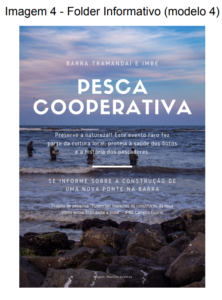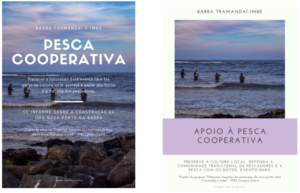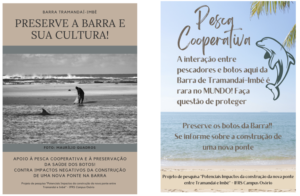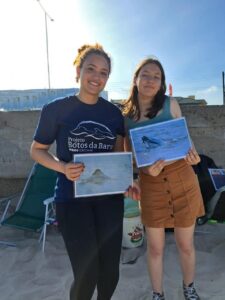News . Best Practices Scientific action in the Environmental Protection of the Tramandaí River in Rio Grande do Sul: Students develop research and communication skills for responsible innovation

This practice reports an open schooling initiative whose aim was to develop a research project about a real-life issue. The project was part of the discipline of Biology in the Technical Course of Informatics and Administration integrated into secondary school in a Federal Institute of Education located on the north coast of Rio Grande do Sul State, Brazil. This open schooling practice was led by teacher Lisiane Zanella during the second semester of 2022. There were two classes of students, approximately a total of 35 students. The students worked in groups of four members and selected their real-life problems to be discussed or solved through project-based learning supported by research and expert researchers. To illustrate the open schooling practices, a group of students selected the theme of environmental protection, focused on studies of the preservation of porpoises in the Tramandaí River bar. This research was based on the publications of a scientist from the marine research laboratory of the Federal University of Rio Grande do Sul (UFRGS), biologist Yuri Camargo. In addition, observations and photos of the local fishing community were made and interviews were carried out with a scientist participant in the Botos da Barra Project. This school project was supported by CONNECT, which provided information and the instrument for evaluation CONNECT-Science for students to reflect on their learning outcomes. This practice was unprecedented and innovative in Rio Grande do Sul because it focused on a real socio-environmental problem identified by the students, in which the construction of abridging between two municipalities can impact on the lives of porpoises already threatened with extinction. The preservation of dolphins in the region is essential, as they are the only marine animals to carry out a rare phenomenon of interaction with humans called cooperative fishing, in which they corner the birds in the river and signal with their heads the moment when fishermen must throw their nets in the water to capture them. The records of these activities are attached below. This phenomenon is currently recognized because it occurs in only three places in the world, in the bar of the Tramandaí River (Tramandaí and Imbé, Rio Grande do Sul State) and Laguna (Santa Catarina State), both located in Brazil, and in Southeast Asia in Myanmar.
CARE: A project plan was proposed by a school teacher for students to identify a local problem. A group of four students from 17 to 18 years – the third year of secondary school at the Federal Institute of Rio Grande do Sul, Osório Campus, Technical Course in Administration, found a piece of news in the newspaper about the construction of a bridge being a threat to the cooperative fishing community carried out by the porpoises (similar to dolphins).
The construction of the bridge in an inappropriate place is a threat to the porpoises, and may lead to their extinction. The construction of the base of the bridge, that is, of the pillars to sustain it within the river, tends to lead to increased pollution and noise in the bar changing the natural habitat of marine animals.
The students were engaged and interested in researching and seeking socio-scientific solutions, including ways of raising awareness among the local population and tourists. The research began with the question of students seeking to find out if the construction of the new bridge would affect the natural and community habitat, as well as how this could occur. In addition to the initial group composed of four students, the interaction of this discussion was shared with twelve other students of the class divided into three more groups. Thus, four main problems were identified: i) the threat of fishing cooperative; ii) sewage treatment in the city of Tramandaí, because the city does not have the entire sewage network, only in the center; iii) pollution in Lagoa do Marcelino; iv) disposal of plastic in the city of Osório.
Knowledge: Students used knowledge about ecology for environmental preservation in the locality where they live. The skills that the students practiced were: elaborating scientific questions; researching scientific articles; interviewing scientists and public officials; examining the consequences of environmental impacts; estimating the risks of building the bridge for the region’s ecosystem; analyzing the percentage of the impacted population; estimating the pros and cons of building the bridge to justify their opinion; using ethics to reflect on the impact of the new bridge on the fishermen’s work; communicating their ideas from the creation of digital folders.
Do: In the end, students prepared digital information folders to be shared on social networks. They completed the activities by sharing a discussion on the topic and the results of the research in a large group. In addition, they also addressed scientific issues with their families and the local community to promote awareness and new knowledge.
Findings related to the Open Schooling approach: The activity was adapted to the curriculum and proved relevant, as it provided an opportunity for students to seek solutions to problems in their locality. In this practice, through scientific research, the students presented justifications to support their opinion and combat real problems. Open schooling can be useful for other teachers through integrative and interdisciplinary projects, which can also seek the solution of local problems in search of sustainable development.
Student results: Students demonstrated great results in terms of their involvement, pleasure, and trust in science. As an example, one student mentioned “that he learned a lot about the region’s ecosystem and circular economy.” Another student stressed “the importance of promoting sustainable development by supporting the local fishing community and ensuring the region’s fish with the protection of the river.” In general, the importance of talking to families was highlighted in order to better understand the importance of sustainable fishing for the region.
Find out more here: Our report.



